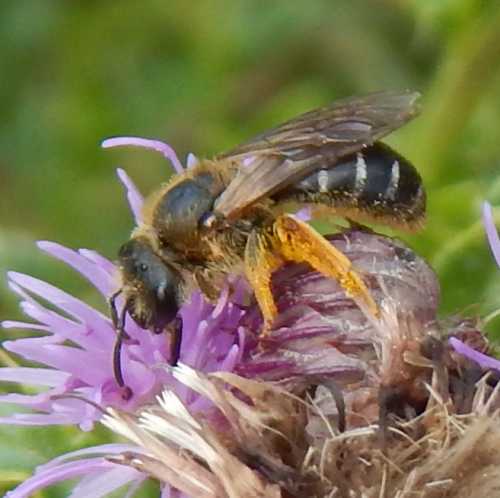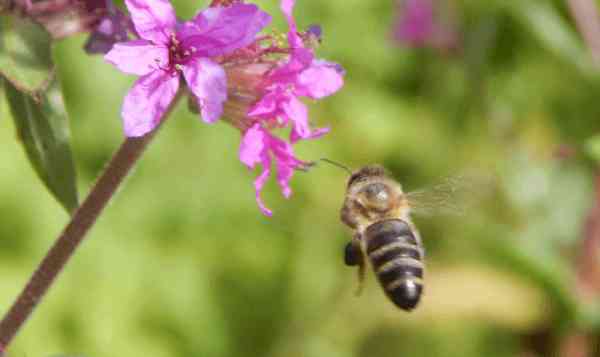How Do Bees Collect Pollen?
The method by which bees collect pollen depends on the species.
The short answer is:
Some bees collect pollen on their hairy bodies, then carry it back to their nests on their hind legs, whilst others carry pollen on their abdomen, or in their crop.
Read on for more detail!
How do bees collect pollen and transfer pollen to the nest?
The fact that pollen is picked up by bees on their furry coats, means that in the process, pollen is transferred between plants, thus aiding the pollination process.
Once the bee returns to its hive or nest, the pollen is stored to be eaten by developing larvae.
Pollen collection
on 'corbiculae' on the hind legs
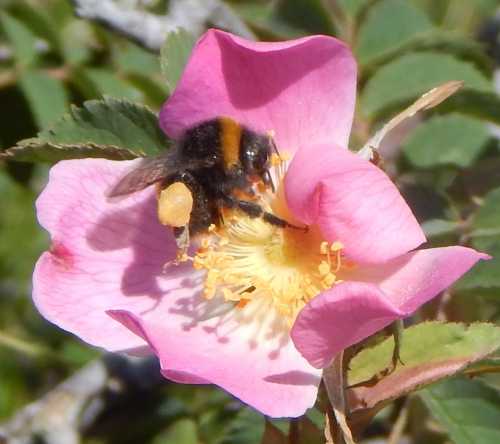 Wild roses provide lots of pollen for bees - including bumble bees.
Wild roses provide lots of pollen for bees - including bumble bees.Some bee species are 'corbiculate', meaning they have pollen baskets or 'corbicula' located on the outside of the hind legs of female bees, and consist of a slightly concave (curved) area surrounded by long hairs.
Probably the most well-known corbiculate bees are bumble bees and honey bees, but this group also includes Euglossini (orchid bees), and Meliponini (stingless bees)1.
As the bee flies through the air, its body becomes positively charged with static electricity. This means that when the bee lands on a flower (thus knocking the pollen from the delicate anthers), some of the pollen particles stick to the static-charged hair covering the bee's body.
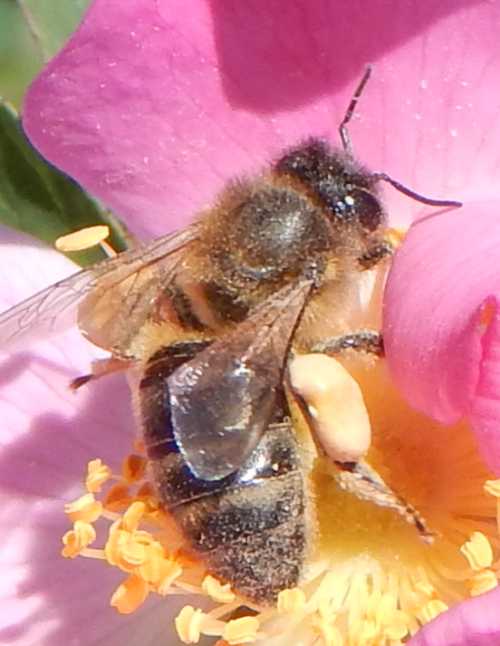 Honey bee worker with full pollen baskets on hind legs.
Honey bee worker with full pollen baskets on hind legs.The bee is thus covered in pollen, and then uses its legs to wipe the pollen from its body down to stiff hairs on the abdomen or back legs.
The pollen is moistened with a little nectar, and packed into the corbiculae, which trap and hold the pollen in place.
Note:
At the beginning of a foraging trip, the pollen baskets will be empty of pollen, and so will be invisible. As the pollen baskets grow increasingly full, they are easy to spot on the hind legs, and may vary in shade, depending on the pollen collected.
Scopa on the legs or abdomen
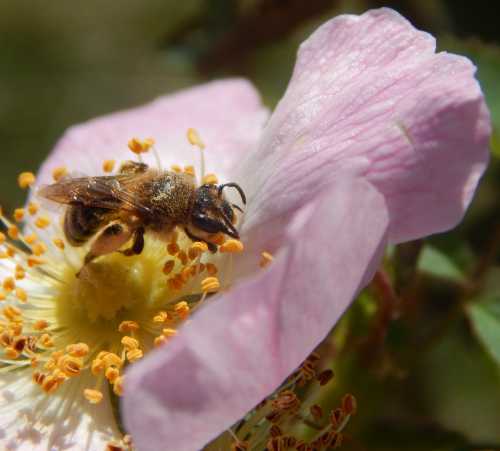 This solitary bee species has gathered quite a lot of pollen on the specially adapted hairs of its hind legs.
This solitary bee species has gathered quite a lot of pollen on the specially adapted hairs of its hind legs.Scopa are dense hairs, usually either on the hind legs, or on the underside of the abdomen on some female bee species.
The scopa on the underside of the abdomen (also called a 'pollen brush') is especially visible in some members of the Megachilidae family, such as the leafcutter bees.
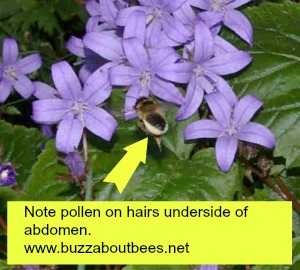 Leafcutter bee collecting pollen on a pollen brush on the underside of the abdomen.
Leafcutter bee collecting pollen on a pollen brush on the underside of the abdomen.Leafcutter bees bees sometimes raise their abdomens when foraging, making the pollen brush especially visible, however, it can also be seen even when the bee is in flight - it's simply a matter of looking out for it.
In other bee species, scopa may be seen on the hind legs. The appearance of the pollen is less compact than is the case with the corbiculae.
Pollen collection in the crop
Hylaeus collect pollen in their crops, whilst Andrena and Colletes species additionally use the sides of the propodeum to collect pollen, which is located at the rear section of the thorax at the base of the abdomen.
How much pollen do bees collect?
Bee species differ in the amount of pollen they are able to collect and carry in one foraging trip (which may require visits to multiple flowers), and also the amount of pollen needed to provision a nest cell varies between species.
For example, the bee Anthemurgus passiflorae must typically take 35 foraging trips to gather enough pollen for one egg, whilst Colletes cunicularis needs just 7 trips.
Also, some very small bees can carry more than their weight in pollen! (Source: Wilson & Messinger Carril).
Will bees collect pollen from any flower?
Some bee species will collect pollen and nectar from a range of plants, whilst others are specialists, and thus rely on a narrower range of plants for food.
Bees can be described as:
Polylectic:
This means pollen may be collected from a wide variety of flowers from different plant types, and from a range of flower colours.
Honey bees are polylectic.
Oligolectic:
This is when pollen is collected from a narrower flower range, perhaps within a single or within very restricted plant types and families.
For example, Chelostoma campanularum (Small Scissor Bee) will only forage from bell flowers and close relatives of the Harebell and Bellflower. (Source: Steven Falk - Guide to Bees Of Great Britain And Ireland).
Monolectic:
Where pollen is collected from a single plant species – although a species considered monolectic in one country may be oligolectic in another, depending on availability of appropriate forage plants!
Do all bees collect pollen?
No, pollen is not collected by:
- Male bees,
- Cleptoparasite bee species (such as nomad bees)
- Cuckoos, such as cuckoo bumble bees.
- In some social species, queens do not collect pollen. This is the case with honey bee queens for example. (Queens of other species do collect pollen, and is the case for bumble bee queens, for example).
References
1. Corbiculate Bees. / Engel, Michael S.; Rasmussen, Claus. Encyclopedia of Social Insects. ed. / Christopher K. Starr. Cham : Springer, 2020.
Do bees sleep?
Apparently they do, but how do we know?
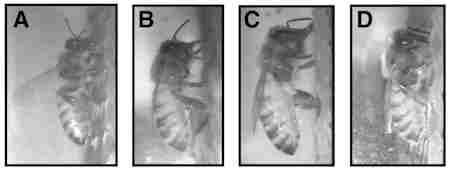
If you found this page helpful or interesting, I'd really be grateful if you would share it with others - if not this page, perhaps another, such as Gardening For Bees.
Thank you so much :) .
